This function receives a list of numpy arrays that consist of cropped parts of an image. The crops are all the same size, except for the right-most and bottom-most images which might be of smaller size.
predictions[2] would return the 3rd sub-image that was cropped from the original image. Each crop is a numpy array. There are WxH crops, enumerated from left to right, top to bottom (so if there are 4 sub-images constituting the width, the 5th image in predictions would be the first sub-image on the left from the 2nd row of sub-images).
crops contains the necessary information to find number of horizontal and vertical images that will constitute the reconstructed images. crops[2][3] will contain the 3rd from the top, 4th from the left image cropped.
The images contained by crops are of smaller dimension than the ones in predictions (I am basically making a model that increases the resolution of images). The reconstructed image if from the images in predictions, arranged in the same order as the ones in crops.
def reconstruct(predictions, crops):
if len(crops) != 0:
print("use crops")
# TODO: properly extract the size of the full image
width_length = 0
height_length = 0
full_image = np.empty(shape=(height_length, width_length))
print(full_image.shape)
# TODO: properly merge the crops back into a single image
for height in range(len(predictions[0])):
for width in range(len(predictions)):
# concatenate here
print(height, width)
return full_image
I was going to use numpy.concatenate, but according to other answers I've seen on SO it wouldn't be an efficient way of doing it (apparently numpy will just recreate a new variable in memory, copy the old one, and add the new data, etc.). So now I'm left wondering how to properly merge my multiple images into a single image. The current idea I was going for was to create a python list of the proper shape and progressively fill it with each numpy array's data, but even that I'm not sure if it's the proper idea.
Here is more or less the kind of bunch of images I'm trying to concatenate into a single image:
Here is the expected result:
And to help you out with understanding what more might be available to you, here is some more code:
def predict(args):
model = load_model(save_dir + '/' + args.model)
image = skimage.io.imread(tests_path + args.image)
predictions = []
images = []
crops = seq_crop(image) # crops into multiple sub-parts the image based on 'input_' constants
for i in range(len(crops)): # amount of vertical crops
for j in range(len(crops[0])): # amount of horizontal crops
current_image = crops[i][j]
images.append(current_image)
# Hack because GPU can only handle one image at a time
input_img = (np.expand_dims(images[p], 0)) # Add the image to a batch where it's the only member
predictions.append(model.predict(input_img)[0]) # returns a list of lists, one for each image in the batch
return predictions, image, crops
# adapted from: https://stackoverflow.com/a/52463034/9768291
def seq_crop(img):
"""
To crop the whole image in a list of sub-images of the same size.
Size comes from "input_" variables in the 'constants' (Evaluation).
Padding with 0 the Bottom and Right image.
:param img: input image
:return: list of sub-images with defined size
"""
width_shape = ceildiv(img.shape[1], input_width)
height_shape = ceildiv(img.shape[0], input_height)
sub_images = [] # will contain all the cropped sub-parts of the image
for j in range(height_shape):
horizontal = []
for i in range(width_shape):
horizontal.append(crop_precise(img, i*input_width, j*input_height, input_width, input_height))
sub_images.append(horizontal)
return sub_images
def crop_precise(img, coord_x, coord_y, width_length, height_length):
"""
To crop a precise portion of an image.
When trying to crop outside of the boundaries, the input to padded with zeros.
:param img: image to crop
:param coord_x: width coordinate (top left point)
:param coord_y: height coordinate (top left point)
:param width_length: width of the cropped portion starting from coord_x
:param height_length: height of the cropped portion starting from coord_y
:return: the cropped part of the image
"""
tmp_img = img[coord_y:coord_y + height_length, coord_x:coord_x + width_length]
return float_im(tmp_img) # From [0,255] to [0.,1.]
# from https://stackoverflow.com/a/17511341/9768291
def ceildiv(a, b):
"""
To get the ceiling of a division
:param a:
:param b:
:return:
"""
return -(-a // b)
if __name__ == '__main__':
preds, original, crops = predict(args) # returns the predictions along with the original
# TODO: reconstruct image
enhanced = reconstruct(preds, crops) # reconstructs the enhanced image from predictions
EDIT:
The answer worked. Here is the version I've used:
# adapted from https://stackoverflow.com/a/52733370/9768291
def reconstruct(predictions, crops):
# unflatten predictions
def nest(data, template):
data = iter(data)
return [[next(data) for _ in row] for row in template]
predictions = nest(predictions, crops)
H = np.cumsum([x[0].shape[0] for x in predictions])
W = np.cumsum([x.shape[1] for x in predictions[0]])
D = predictions[0][0]
recon = np.empty((H[-1], W[-1], D.shape[2]), D.dtype)
for rd, rs in zip(np.split(recon, H[:-1], 0), predictions):
for d, s in zip(np.split(rd, W[:-1], 1), rs):
d[...] = s
return recon


